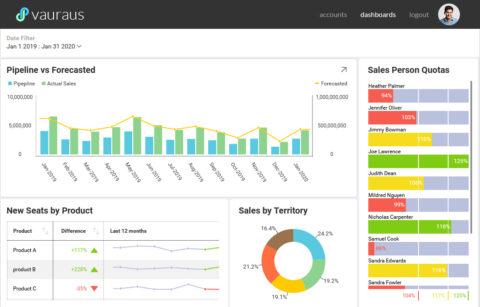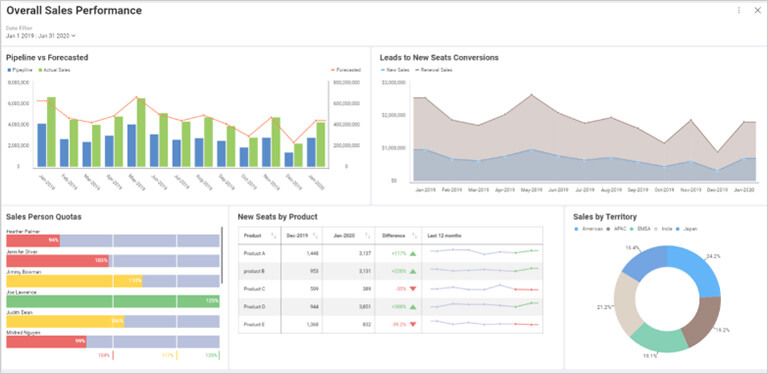
Scriptly Helps Pharmacies Identify Trends in Real Time with Reveal

Data-driven cultures make data an imperative part of everyone’s daily workflow, and these organizations use data to execute and prioritize initiatives. A culture that is data-driven also instills trust and commitment in all members of the organization as they can collaborate fluidly with transparency based on shared metrics with data at their fingertips.
This whitepaper will give you the keys to building a culture where everyone collaborates based on data, helping to make smarter, faster decisions. From your business leaders to analysts to your information workers – everyone is included in ensuring a data-driven culture is successful.
Fill out the form to continue reading.
We are estimated to create more than 2.5 quintillion bytes of data daily. And this is only expected to increase. But many companies and organizations have been unable to fully harness this data to enhance business performance.
Those organizations that use data strategically rely on data as a key asset for gaining insights and influencing business processes across the organization. They can make smarter, data-based decisions rather than rely on assumptions or “gut feelings.”
Data-driven insights can help a marketing team, for example, discover new trends and pinpoint leaks in its customer buying funnel. The ability to gather, understand, and identify key opportunities with your data will set you up for success.
By 2022, more than half of major new business systems will incorporate continuous intelligence that uses real-time context data to improve decisions.
Gartner Data & Analytics Summit, June 2020
The role of data and analytics is changing, from being a stand-alone discipline to becoming a catalyst for digital strategy or transformation.
How to Craft a Modern, Actionable Data and Analytics Strategy That Delivers Business Outcomes, Gartner, Oct 2019
While it is easy for many people to trust their intuition when making decisions, is it the best approach to making business decisions? More and more, the answer is “no.” With data more easily available, especially in those applications that use embedded analytics, people can more quickly reference data in data visualizations or dashboards to make better, faster decisions.
Therefore, creating a data-driven culture is important, especially in these key areas:
According to a survey conducted by the Business Application Research Council {BARC), “establishing a Data Driven culture” was the third most important trend in Business Intelligence in 2020. It is becoming more and more clear how data is changing the way that businesses and people operate in their daily ways
The road to recovery is paved with data.
Kate Smaje, a senior partner and global co-leader of McKinsey Digital
In their report on digital transformation, McKinsey Digital notes that data is providing the fuel to power better and faster decisions and states: “High-performing organizations are three times more likely than others to say their data and analytics initiatives have contributed at least 20 percent to EBIT (from 2016–19).
Here are more specifics on the benefits a data-driven culture provides:
The following chapters will give you keys to building a culture where everyone collaborates about data and makes smarter, faster decisions. From your business leaders to analysts to your information workers – everyone is included in ensuring a Data Driven culture is successful.
Embed data and analytics into business strategy and digital transformation by creating a vision of a Data Driven enterprise, quantifying and communicating business outcomes and fostering business changes fueled by data.
How to Craft a Modern, Actionable Data and Analytics Strategy That Delivers Business Outcomes, Gartner, June 2020
Businesses worldwide are beginning to adopt data and new trends such as AI and Machine Learning. However, culture is still a key factor holding them back from using that data effectively. And where does company culture start? At the very top.
Leaders need to shift the organization’s mindset to begin embracing data and alter how everyone approaches decision-making. According to a survey conducted by Deloitte and published in the Harvard Business Review, 63% of executives do not believe their companies are data-driven. So, how can you change the culture?
By taking the following actions, you can send a message to the rest of your organization:
By 2022, more than half of major new business systems will incorporate continuous intelligence that uses real-time context data to improve decisions.
Gartner Data and Analytics Summit, Mumbai, India, June 2020,
Creating a data-driven culture relies on a long-term commitment to using data to make decisions for everyone in the organization. An initiative like this cannot be a set-it-and-forget-it process. Part of this is establishing a shift in culture. Being data-driven is more than just creating dashboards and looking at numbers – it is about changing your organization’s culture to think analytically.
To help drive this shift in culture and maintain commitment long-term you should:
Most employees and management in organizations want to know that they can trust the analytics they see. This is why it is important that everyone in your organization is basing their decisions on the same metrics. Therefore, having a single source of truth is so important. Without it you can have employees pulling metrics from different sources and risking inconsistencies, resulting in less trust in the data.
When there is one place for your users to find answers and consistent data, you eliminate the need for people to begin searching for different systems. This also makes it easier for the data administrators, so they only need to maintain data in one location.
Take some of the following steps to build out an environment that serves as a single source of truth that the whole organization can draw from:
By 2023, data literacy will become an explicit and necessary driver of business value, demonstrated by its formal inclusion in over 80% of data and analytics strategies and change management programs.
Gartner

Knowing where to access data is just one piece of the puzzle. End users also need the skills to understand the data. Adjusting to working with data means changing the way we operate in our day-to-day activities. This means that people may not have the needed skills to be data-driven out of the box.
If your end users do not have a clear direction and understanding of the data, they will begin making assumptions, which contradicts a basic tenet of a data-driven organization.
Users also need to know the best way to consume this data so that it is telling the proper story. Following dashboard best practices is key for users who create and view different charts. Read our whitepaper about Best Practices for Creating Compelling Visualizations to learn more.
Developing a data literacy plan across organizations means you should ensure you accomplish the following action items:
Trying to force people to conform their work to preestablished numerical goals tends to stifle innovation and creativity—valuable qualities in most settings. And it almost inevitably leads to a valuation of short-term goals over long-term purposes.
Jerry Z. Muller, The Tyranny of Metrics
The first step in measuring business improvements is making sure that the key performance indicators (KPIs) are the ones that matter and are tied to your organizational goals. After all what you are tracking is what your efforts are working towards to improve, right?
First, ensure you understand a key performance indicator (KPI). KPIs are measurements that tell you how a process is performing so appropriate business decisions can be made. Organizations should have organizational-wide KPIs, such as sales targets, department-wide KPIs, such as the number of inbound leads marketing is generating, and performance-level KPIs, such as employee satisfaction, customer satisfaction, and customer retention.
So how do you know if you are tracking the right metrics or not? These steps will help you focus your KPIs and help you narrow down the ones that matter most:
Every beginner possesses a great potential to be an expert in his or her chosen field.
Lailah Gifty Akita, Think Great: Be Great!
Data can only make an impact if it’s incorporated in the decision-making process:
Find key business stakeholders with a visibility and data mindset, give them data literacy training, and empower them to promote a Data-Driven culture in your organization.
So, what is embedded analytics, and how does it tie back to creating a data-driven culture?
In contrast to traditional BI, which requires users to leave their workflow applications to look at data insights in a separate set of tools, embedded analytics lets users view data visualizations or dashboards in context—while in the application itself. Bringing data right into the user’s workflow without any disruption. And in return, delivering more value.
Introducing data into a user’s daily workflow makes it easier for people to see and act on insights and help program them to constantly think analytically.
By 2023, data literacy will become an explicit and necessary driver of business value, demonstrated by its formal inclusion in over 80% of data and analytics strategies and change management programs.
10 Ways CDOs Can Succeed in Forging a Data-Driven Organization, Gartner